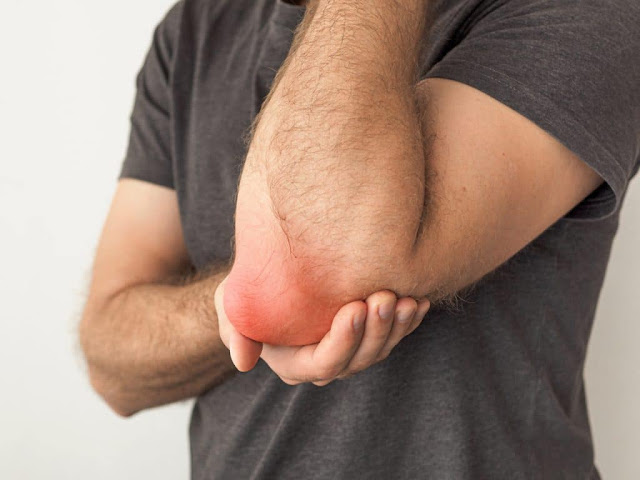Tennis elbow and gout are two distinct medical conditions that affect different parts of the body and have different causes, symptoms, and treatments. While they may both cause joint pain, understanding the differences between tennis elbow and gout is crucial for accurate diagnosis and appropriate management. Let's explore each condition in detail.
Tennis elbow, medically known as lateral epicondylitis, is a condition that primarily affects the tendons of the elbow. It is often caused by repetitive motions and overuse of the forearm muscles, such as those involved in gripping and lifting. Despite its name, tennis elbow can occur in individuals who do not play tennis. Some common risk factors for tennis elbow include sports activities, manual labor, and certain occupations that involve repetitive arm movements.
The condition is characterized by inflammation and microtears in the tendons, leading to pain and tenderness on the outer part of the elbow. The pain may radiate down the forearm and worsen with activities that involve gripping or lifting. Rest, ice, physical therapy, and anti-inflammatory medications are commonly used to manage tennis elbow. In severe cases, corticosteroid injections or surgery may be recommended.
On the other hand, gout is a form of inflammatory arthritis that results from the accumulation of uric acid crystals in the joints. Uric acid is a normal waste product formed during the breakdown of purines, which are substances found in certain foods and produced by the body. Gout typically affects the big toe joint, although it can also occur in other joints such as the ankles, knees, wrists, and elbows.
The condition is caused by an overproduction or underexcretion of uric acid, leading to the formation of sharp crystals in the affected joint. Gout attacks often come on suddenly, with intense pain, swelling, redness, and warmth in the affected joint. The pain is often described as excruciating and can be triggered by factors such as alcohol consumption, certain foods (e.g., organ meats, seafood, and sugary drinks), dehydration, obesity, and certain medications.
The initial treatment for gout involves managing the acute attack with anti-inflammatory medications and pain relievers. Long-term management includes lifestyle modifications, such as dietary changes, weight loss, increased fluid intake, and medications to reduce uric acid levels.
In summary, the main differences between tennis elbow and gout are as follows:
- Location: Tennis elbow affects the tendons of the elbow, causing pain in the outer part of the joint. Gout primarily affects the big toe joint but can also affect other joints, including the elbows.
- Cause: Tennis elbow is typically caused by repetitive motions and overuse of the forearm muscles. Gout results from the accumulation of uric acid crystals due to overproduction or underexcretion of uric acid.
- Symptoms: Tennis elbow presents with pain and tenderness on the outer part of the elbow, often radiating down the forearm. Gout causes intense pain, swelling, redness, and warmth in the affected joint, with the big toe being the most commonly affected.
- Triggers: Tennis elbow is often triggered by activities involving gripping and lifting, while gout attacks can be triggered by factors such as alcohol consumption, certain foods, dehydration, obesity, and medications.
- Treatment: Tennis elbow is managed with rest, ice, physical therapy, and anti-inflammatory medications. In severe cases, corticosteroid injections or surgery may be necessary. Gout treatment involves managing acute attacks with anti-inflammatory medications and pain relievers, as well as long-term measures to reduce uric acid levels, such as dietary changes, weight loss, increased fluid intake, and medications.
It is important to consult a healthcare professional for an accurate diagnosis and appropriate treatment of either tennis elbow or gout. They will be able to perform a thorough evaluation, consider your symptoms, medical history, and conduct any necessary tests to differentiate between the two conditions. This will ensure that you receive the most effective treatment plan tailored to your specific needs.
Additionally, seeking medical attention is crucial because misdiagnosis or delayed treatment can lead to complications and prolonged discomfort. Some complications associated with tennis elbow include chronic pain, limited range of motion, and difficulty performing daily activities. In the case of gout, untreated or poorly managed gout attacks can result in recurrent flare-ups, joint damage, and the development of tophi (collections of uric acid crystals).
While both tennis elbow and gout may cause joint pain, their underlying causes, and treatments are distinct. Understanding the differences between these conditions can help you make informed decisions about seeking medical care and following the appropriate treatment plan. Remember, each individual's situation is unique, and a healthcare professional is the best resource to guide you through diagnosis, treatment, and management of tennis elbow or gout.
CAUTION: Now I need you to pay very close attention to this
GOUT gone for good in 4 weeks
Gout is pretty unpleasant, to say the least.
But what can you do about it...
- Eat less meat?
- Drink less alcohol?
- Drink more water?
Follow the usual advice?
I'm sure you already tried all that, but it made zero difference didn't it?
The pain remained as bad as ever?
Our doctors mean well, but the medications they prescribe are trying to manage the disease rather than cure it. I'm sure that's not what you want. You want your gout cured, not managed. Right?
But now there is a new discovery that changes everything about how we treat gout. Researchers from the US and Europe have worked out what causes gout.
In fact, they've known for some years now. And finally, there is a drug-free, supplement-free natural health approach that turns this new knowledge into a cure.
...a gout cure, which has worked for thousands of people already. It's not complicated. Most people get rid of their gout in days. No pain. No nothing. Simply no gout.
It's your turn now. Click here, and I'll tell you how it works...


